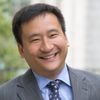Among the most startling experiences I have had with race is seeing other Asian Americans. I mean being around a critical mass whose lives span the range of human experience versus being virtually alone save for scant contact with a circumscribed subculture.
My wife, also Asian American, and I had this uncanny experience when we came to San Francisco.
She and I would be regarded as very different in Asia: she is of Japanese descent, I Chinese. When we have visited Asia, it is clear we are not "going back" there in any meaningful sense. We are foreign not only in formal terms of carrying United States passports but in ordinary behavior. As Americans, for example, we occupy more space; we expect to maintain greater physical distance from strangers walking down the street much less crowded into a subway compartment. Neither of us knows the niceties of bowing or the rituals of Buddhism or Shinto. We bumble around, asking directions from tourists who are white, to their bemusement.
"Look at all the Asians!" we exclaimed to one another after arriving in the city by the bay. It has had a significant Asian population since it was established as the great urban settlement of the American Pacific Coast. Neither us had been in an environment such as that. She hails from St. Louis, the gateway to the west; my hometown is Detroit, the Motor City.
Our perceptions are based on fact. Although Asian Americans are a fast growing group, the trends are not the same coast to coast -- as this map shows vividly. In 2010, while Asian Americans constituted more than five percent of the nation, they made up just shy of fifteen percent of California. We are approximately 36 percent of the residents of San Francisco (In our home states of Missouri and Michigan, the comparable figures are 2.1 and 2.8 percent, respectively.) Even in San Francisco, Asian Americans have only recently established themselves politically. They once were confined to specific locales, boxed in by deeds bearing covenants not to sell land to them, threatened by violence if they strayed.
When we arrived in San Francisco, having flown from Washington, D.C., the capitol where we had resided as a married couple, we went to breakfast early, due to jet lag. As we settled down at a neighborhood cafe, in walked four burly cops. They probably were ending their shift.
The punchline is that three of the four -- uniformed in blue, armed, with regulation haircuts, comfortable in their camaraderie -- were of Asian heritage. (For all we know, given intermarriage rates, the last might have been too.) In all the places we had been prior, major metropolitan areas, you would have had difficulty mustering three Asian American law enforcement officers if you sent out a call. In San Francisco, where the chief has been Asian American, they were just going about their business. They no doubt would be surprised if told they were an example of any demographic phenomenon.
We discovered Asian Americans as we had not seen them before. Asians, from tourists to immigrants to sixth-generation Californians, were everywhere, doing everything. They were not limited to operating laundries and running restaurants, nor merely overrepresented in technical professions. They also were bank clerks, postal carriers, bus drivers, entrepreneurs, and politicians. They spoke with every accent, Including from Latin America (the best Nicaraguan restaurant in the Mission District is run by Latin American Chinese). They subscribed to every political perspective from evangelical Christian to LGBT activist. There are even Asian American panhandlers, troubled souls wandering downtown. For my wife and me, the diversity within diversity was new and novel.
The region boasts an historic Chinatown, the most sizable on the West Coast; a newer concentration of Chinese on Clement Street, joined by Southeast Asians; another, distinctive Chinatown in Oakland; a Japantown, albeit mostly emptied out during the internment; an historical Japantown in San Jose; Pacific Islanders in Bayview; and Filipinos in adjacent Daly City. Silicon Valley, the center of innovation, likewise is heavily Asian.
Ironically, Asian Americans might face displacement as a consequence of real estate speculation. They are losing leases, residential and commercial. The Chinese working class is leaving. My wife and I found ourselves bidding for houses against Asian buyers with whom we could not compete.
People, Asian Americans among them, likely do not have a good sense of the geographic variety of our democratic experiment. So much changes when there is a sense of community. In the San Francisco Bay Area, to have straight black hair, almond eyes, and yellow skin is to be normal. Elsewhere, even in Los Angeles or New York City, it is not so much.
All the same, I would rather have come to this point from elsewhere than be forced to leave it. San Francisco is the ultimate Asian American destination. I feel at home.
